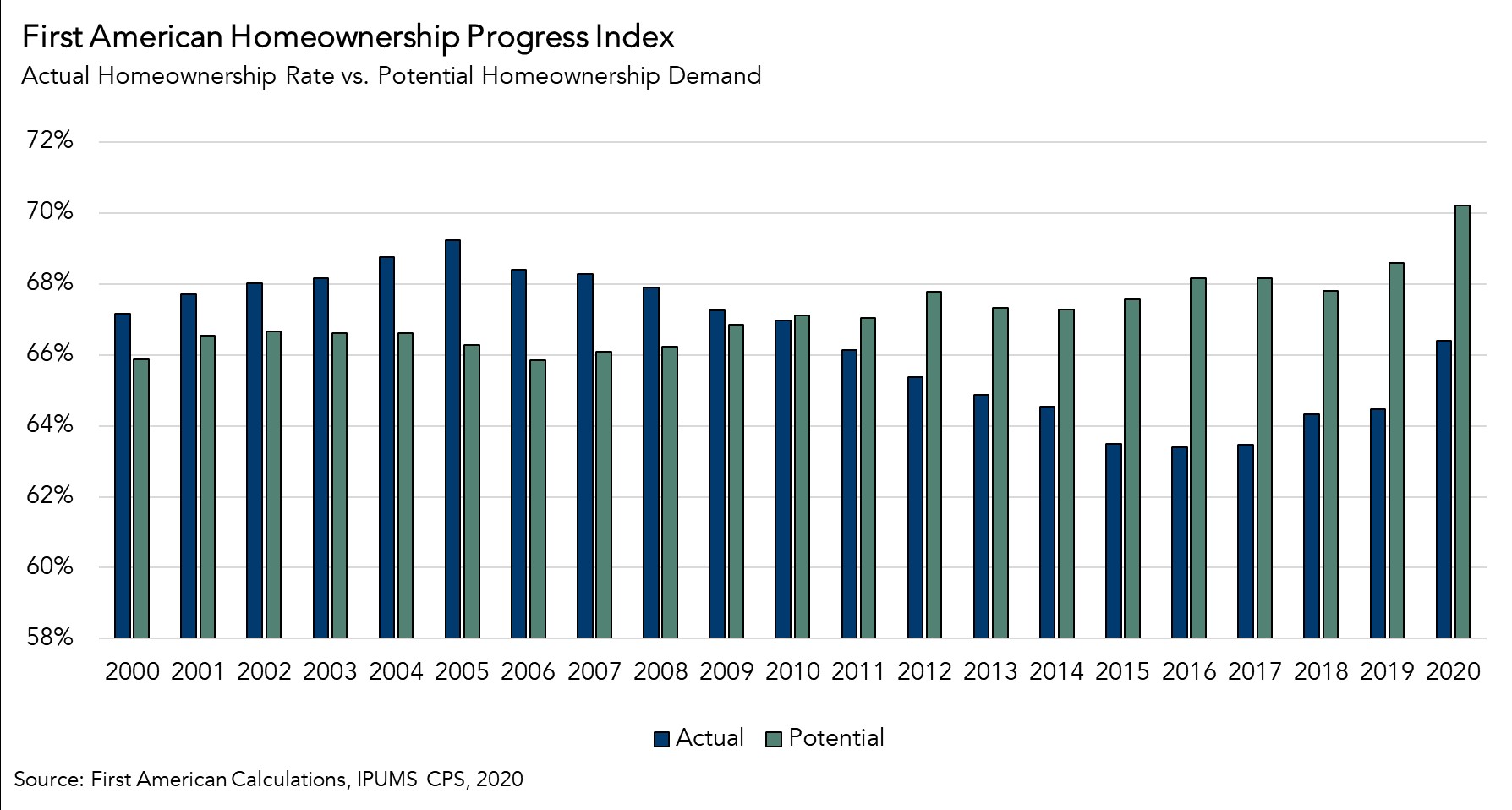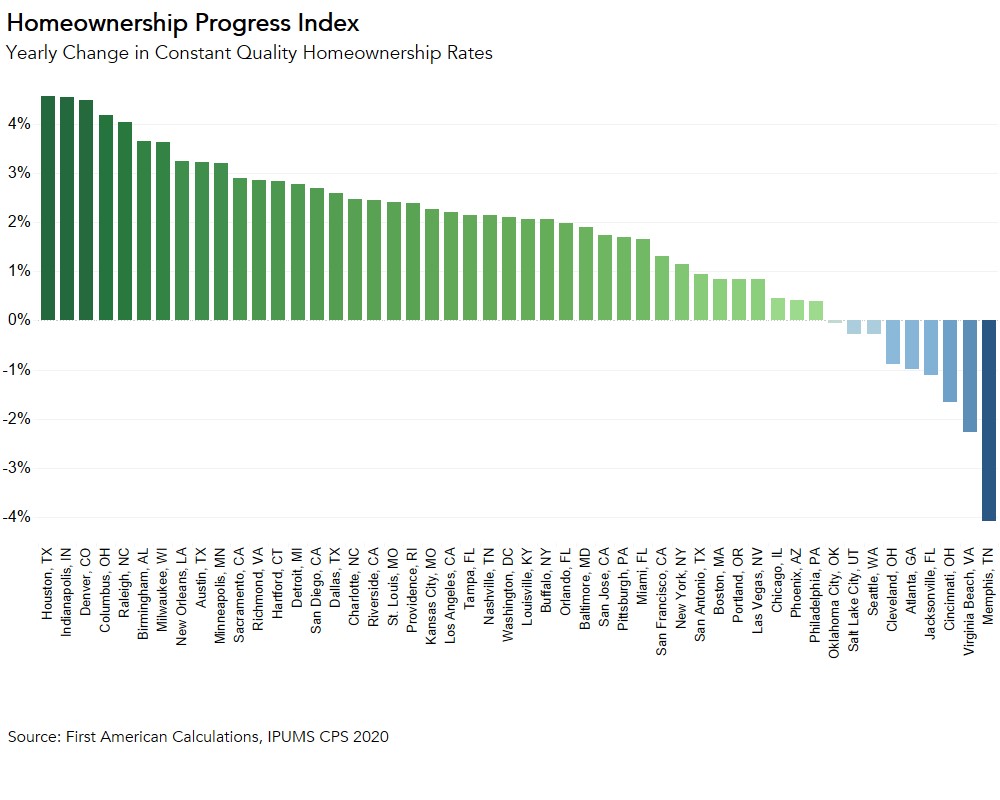National Homeownership Month takes on a new meaning this year, as the pandemic has redefined the role of a home. A home is not just a dwelling or even just a vehicle for wealth creation, but also an office, a classroom, a daycare and even a gym. A home, now more than ever, has become a top priority for American households. The broadening role of the home in American life powered the housing market to multiple records during this unprecedented time: the fastest house price appreciation since 2005, the lowest days on market in the history of record-keeping, the lowest mortgage rates ever, and the greatest cumulative number of purchase mortgage applications since 2008. But, while the pandemic accelerated the demand for homeownership, homeownership was on the upswing before the pandemic hit. Fueled by a combination of demographic and economic factors, the homeownership rate has risen steadily since reaching a generational low of 63 percent in 2016, and 2020 was no different.
"Millennials now have the greatest influence on the housing market and remain poised to fuel a “roaring 20s” of homeownership demand."
The homeownership rate is influenced by underlying demographic and economic factors, as well as housing market conditions. Close examination of these underlying forces can provide a more in-depth understanding of the changes in the homeownership rate over time. Our annual Homeownership Progress Index (HPRI) accounts for the influence of critical lifestyle, societal and economic trends on the likelihood of owning a home, providing a measure of potential homeownership demand.

Homeownership Rate Continues to Underperform Potential
A historical comparison of the homeownership rate with potential homeownership demand according to the HPRI reveals that from 2000 through 2009 the actual homeownership rate exceeded potential homeownership demand by an average of 1.7 percentage points. When the actual homeownership rate exceeds the HPRI, it indicates that the homeownership rate is above the levels supported by demographic and economic fundamentals and may be elevated by other market dynamics. This was indeed the case at the peak of the gap (3 percentage points) in 2005, when speculation and easy access to credit caused the actual homeownership rate to exceed potential homeownership demand.
However, since 2010, potential homeownership demand, based on the lifestyle, societal and economic factors tracked in our HPRI model, has exceeded the actual homeownership rate. When the HPRI exceeds the actual homeownership rate, it indicates that homeownership may be restricted by market forces, like an historically low supply of homes for sale. While the ongoing housing supply shortage has likely hindered the actual homeownership rate, potential demand has strengthened further as a result of demographic and lifestyle dynamics.
In 2020, rising house-buying power, driven primarily by low mortgage rates, was a primary driver of potential demand. Between 2011 and 2020, the annual average of the 30-year, fixed-rate mortgage has been near or below 4.5 percent, significantly below the pre-2011 average of 8.9 percent. In 2020, mortgage rates fell to their lowest annual level in history (3.1 percent), boosting house-buying power and further elevating potential homeownership demand, which exceeded the actual homeownership rate by 3.8 percentage points.
Millennials Continue to Drive Potential Homeownership Demand
Millennials are the largest generation in U.S. history, and the majority turned 30 in 2020. Historically, millennials have delayed the critical lifestyle choices often linked to buying a first home, including getting married and having children, in order to further their education. This is clear in cross-generational comparisons of homeownership rates which show millennials lagging their generational predecessors. At age 30, 42 percent of millennials own homes, compared with 48 percent of Gen Xers and 51 percent of Baby Boomers at the same age. Yet, millennials are narrowing this gap as they move into a new phase of their lives.
In 2020, potential homeownership demand improved by 3.5 percentage points for millennials, the largest increase among the major generational cohorts. Generation Z followed with a 2.5 percentage point increase in the HPRI, Generation X increased by 2.1 percentage points and Baby Boomers increased by 1.3 percentage points. While millennial homeownership has been delayed relative to their generational predecessors, millennials now have the greatest influence on the housing market and remain poised to fuel a “roaring 20s” of homeownership demand.
Despite the pandemic-driven economic downturn in 2020, millennials continued to age into the key lifestyle decisions that increase the likelihood of homeownership. In 2021, while faster nominal house price appreciation may begin to erode the affordability boost from low mortgage rates and rising income, these lifestyle decisions will persist. Buying a home is both a financial and lifestyle decision, and despite growing affordability headwinds, millennials continue to transition to their prime homebuying age, helping to boost potential homeownership demand in the years ahead.
2020 HOMEOWNERSHIP PROGRESS INDEX
The First American Homeownership Progress Index (HPRI) showed that in 2020:
- Nationally, potential homeownership demand represented by the HPRI increased 1.6 percentage points in 2020 compared with 2019, based on changes in the underlying lifestyle, societal and economic data.
- Some factors that increased potential homeownership demand included house-buying power growth[1] (+2.1 percent), an aging population (+0.4 percent), rising educational attainment (+0.2 percent), the higher share of married households (+0.02 percent), and the increase in the number of children per household (+0.009 percent).
- The increase in the U-6 unemployment rate[2] decreased potential homeownership demand (-0.3).
- Potential homeownership demand increased from 2019 to 2020 in 41 of the 50 metropolitan areas tracked by First American, as demographic and economic trends in these cities raised the likelihood of homeownership.
[1] The 2020 house-buying power uses March 2020 ASEC household income results, which reports the total money income during the previous calendar year of all adult household members. This number was elevated in 2020.
[2] The 2020 HPRI will not capture the full effect of the COVID crisis as the ASEC survey was conducted in March 2020.
2020 Homeownership Progress Index State Highlights
- The five states with the greatest year-over-year increase in potential homeownership demand are: Alabama (+3.7 percentage points), Rhode Island (+3.3 percentage points), Idaho (+2.4 percentage points), Texas (+3.2 percentage points) and Connecticut (+3.1 percentage points).
- The only states with a year-over-year decrease in potential homeownership demand are: South Carolina (-0.8 percentage points), Iowa (-0.4 percentage points), and Tennessee (-0.3 percentage points).
2020 Homeownership Progress Index Local Market Highlights
- Among the largest 50 Core Based Statistical Areas (CBSAs), the five markets with the greatest year-over-year increase in potential homeownership demand are: Houston (+4.6 percentage points), Indianapolis (+4.5 percentage points), Denver (+4.5 percentage points), Columbus, Ohio (+4.2 percentage points), and Raleigh, N.C. (+4.0 percentage points).
- Among the largest 50 CBSAs, the five markets with the greatest year-over-year decrease in potential homeownership demand are: Memphis, Tenn. (-4.1 percentage points), Virginia Beach, Va.(-2.3 percentage points), Cincinnati (-1.6 percentage points), Jacksonville, Fla. (-1.1 percentage points), and Atlanta (-1.0 percentage points).

Next Release
The next release of the First American Homeownership Progress Index will be posted in June 2022.
What makes it a Homeownership Progress Index?
Traditional measures of homeownership rates do not account for shifts in underlying demographic or economic factors. Instead, they report just the share of households that are homeowners. Analysis based on these traditionally calculated homeownership rates has resulted in mistaken conclusions that are often propagated as conventional wisdom. The HPRI provides a deeper look into the changes to homeownership rates over time by accounting for, and isolating, the impact of critical lifestyle, societal and economic trends that influence the likelihood of renting or owning a home.
Why does the HPRI tell a different story than other measures?
Changing demographic and economic factors either increase or decrease someone’s potential to be a homeowner. For example, increasing marital rates, household size, educational attainment, income and improving economic conditions all increase potential demand for homeownership. The HPRI measures the potential for homeownership demand based on these underlying factors. For example, the potential for, or likelihood of, homeownership may increase because of rising educational attainment or income growth. It’s important to point out that the likelihood of homeownership doesn’t have to match the actual homeownership rate. For example, it’s possible that someone may be highly likely to desire homeownership but are unable to find any houses they can afford to buy. In that case, potential homeownership demand would be higher than the actual homeownership rate.
What do the HPRI number values mean?
The HPRI value is the percent of households that are likely to be homeowners, based on underlying lifestyle, societal, and economic conditions, instead of renters. Changes over time in the HPRI are caused by changes in the underlying lifestyle, societal and economic trends.
About the First American Homeownership Progress Index
The First American Homeownership Progress Index is an economic model that uses annual IPUMS CPS individual anonymized census survey data to measure the influence of household circumstances and demographic, societal and economic characteristics on one’s choice to own a home. Demographic characteristics include age, race/ethnicity, gender, marital status and number of children. Additionally, the model includes educational attainment, income, the 30-year fixed rate mortgage rate and the unemployment rate to help explain changes in homeownership rates. The individual factors influencing homeownership can be isolated, while all other factors are held equal, to provide a unique perspective on the impact the isolated factor has on the likelihood of homeownership.
The HPRI can provide the likelihood of homeownership for a given demographic and economic profile. For example, an educated man with two children and a higher income will have a higher likelihood of homeownership than a single man without a higher education degree.
Methodology
The methodology statement for the First American Homeownership Progress Index is available at http://www.firstam.com/economics/homeownership-progress-index.
Disclaimer
Opinions, estimates, forecasts and other views contained in this page are those of First American’s Chief Economist, do not necessarily represent the views of First American or its management, should not be construed as indicating First American’s business prospects or expected results, and are subject to change without notice. Although the First American Economics team attempts to provide reliable, useful information, it does not guarantee that the information is accurate, current or suitable for any particular purpose. © 2021 by First American. Information from this page may be used with proper attribution.



